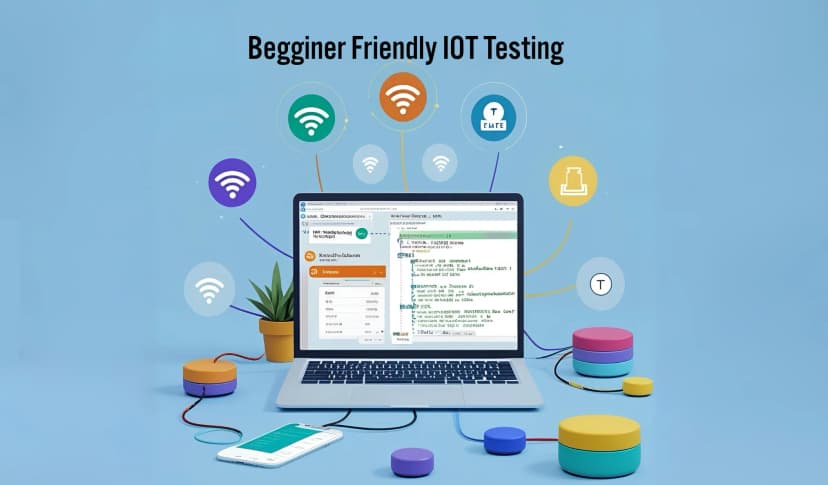Beginner’s Guide to IoT Testing: Types, Tools & Protocol Ecosystem
The Internet of Things (IoT) is transforming industries at a rapid pace. From wearable health trackers and smart thermostats to connected cars and industrial robots, IoT systems are now part of daily life. These devices collect, transmit, and act on data in real time — and even a small fault can have a major impact.
As IoT adoption accelerates, testing has become one of the most critical parts of development. IoT testing ensures that devices work reliably, communicate securely, and deliver consistent performance across different environments, networks, and platforms.
What Is IoT Testing?
IoT testing is the process of validating the entire IoT ecosystem — devices, firmware, network protocols, companion apps, cloud integrations, and analytics platforms. It’s more than just software testing; it involves the interaction of physical devices with digital systems.
The objective is to confirm that devices can connect and operate smoothly, data flows correctly and securely, and the system as a whole meets performance, security, and interoperability requirements.
Why IoT Testing Is Critical
IoT devices are often used in mission-critical environments — hospital monitoring systems, factory automation, transportation, and even national infrastructure. A single malfunction could lead to safety risks, data breaches, or service downtime.
IoT systems face unique risks: variable network conditions, multi-vendor components, protocol mismatches, and security vulnerabilities. Testing isn’t just about catching bugs; it’s about building trust and ensuring resilience in unpredictable environments.
Types of IoT Testing
Different types of testing address different risks and performance goals.
- Functional Testing verifies that the device’s primary features — such as activation, pairing, data capture, and automation — work correctly.
- Connectivity Testing checks stability over communication channels like Wi-Fi, Bluetooth LE, Zigbee, LoRaWAN, and 5G.
- Protocol Compliance Testing ensures devices follow standards like MQTT, CoAP, HTTP, and AMQP.
- Performance Testing evaluates latency, throughput, battery life, and system behavior under stress.
- Security Testing identifies vulnerabilities like firmware tampering, unauthorized access, or data interception.
- Interoperability Testing confirms devices from different manufacturers can work together without conflict.
- Cloud Integration Testing validates synchronization with platforms such as AWS IoT, Azure IoT Hub, and Google Cloud IoT.
IoT Testing Lifecycle & Workflow
Effective IoT QA follows a structured workflow:
- Requirement Analysis – Understanding device specifications, communication protocols, and environmental conditions.
- Test Environment Setup – Configuring physical and virtual test labs with real devices, simulators, and network emulators.
- Test Case Design – Creating functional, connectivity, and security scenarios based on use cases.
- Test Execution – Running automated and manual tests across devices, networks, and cloud services.
- Defect Logging & Analysis – Capturing issues with detailed logs from device, application, and network layers.
- Regression Testing – Verifying fixes without introducing new issues.
- Final Validation & Certification – Ensuring readiness for deployment.
Common IoT Protocols
Protocols define “how IoT devices exchange data.”
| Protocol | Layer | Primary Use |
| MQTT | Application | Lightweight publish/subscribe messaging |
| CoAP | Application | RESTful API for constrained devices |
| Zigbee | Network | Mesh networking for smart devices |
| Bluetooth LE | Network | Short-range, low-power communication |
| LoRaWAN | Network | Long-range, low-power IoT connectivity |
| HTTP/HTTPS | Application | Standard web and API data transfer |
| AMQP | Messaging | Secure enterprise-level messaging |
| DDS | Data-centric | Real-time distributed control systems |
IoT Testing Tools
Testing IoT systems requires tools for different layers.
- Wireshark – Packet inspection and protocol debugging
- MQTT Explorer – Messaging protocol validation
- Postman – API testing and integration checks
- IoTIFY – Virtual device simulation in the cloud
- JTAG/UART Debuggers – Hardware and firmware diagnostics
- Appium/Selenium – UI testing for companion apps
- Burp Suite/MobSF – Security scanning for applications
- AWS IoT Device Tester – Platform certification
Real-World Examples of IoT QA
A connected thermostat must not only adjust temperature but also maintain secure communication with a mobile app, update firmware without interruption, and handle network dropouts gracefully.
In industrial IoT, vibration sensors on machines must continuously send accurate data to a central monitoring system, even in high-interference environments. Testing ensures these systems stay reliable in real-world conditions.
Best Practices for IoT Testing
Shorter, iterative test cycles work best for IoT due to frequent firmware updates. Use both physical devices and simulators for broader coverage. Ensure logging is enabled across all system layers to speed up root cause analysis.
Security should be integrated from the start — not added as an afterthought. Always test in varied network conditions to mimic real-world unpredictability.
Industry Use Cases
IoT testing needs vary by industry. In healthcare, accuracy and data security are paramount. In automotive, real-time responsiveness and safety standards dominate. Smart homes demand interoperability and seamless user experiences, while manufacturing requires durability under extreme environmental conditions.
Skills & Roles in IoT QA Teams
IoT QA teams often combine skills in software testing, hardware debugging, network analysis, and cloud integration. Testers may work alongside firmware developers, network engineers, and security specialists to ensure comprehensive coverage.
Final Thoughts
IoT is expanding rapidly, and with it, the need for thorough, reliable testing. Successful IoT QA blends hardware and software expertise, ensuring products are secure, compatible, and performance-ready.
For testers, IoT offers an exciting career path. For businesses, it’s an investment in safety, customer trust, and market success.
Ensure Your IoT Products Are Market-Ready
Testriq offers full-cycle IoT testing, from device connectivity to cloud integration. We help businesses launch secure, high-performing, and reliable IoT solutions.
About Atul Ahire
Expert in IoT Device Testing with years of experience in software testing and quality assurance.
Found this article helpful?
Share it with your team!
